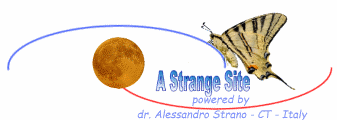La Metamorfosi dell'Etna / Modifications in Morphology of Etna / La Metamorfosis del volcán Etna
A seguito dell'attività sismica ed effusiva avutasi nel corso del 2001, l'Etna ha subito profonde modifiche morfologiche. Osserviamo le due foto.
In the year 2001 the seismic activity and the effusive activity have caused deep morphological modifications in the volcano Etna. Let's get a look at these photos.
El volcán Etna sufrió profundas modificaciones morfológicas en 2001. Miremos las fotografías.

foto / photo by / fotografía Giuseppe Petralia
L'Etna non smette mai di farsi notare; la foto che vedete è stata scattata in novembre 2002, durante un'intensa fase di emissione di cenere vulcanica.
This photo was taken in November 2002 during an intensive emission of volcanic ash.
Esta fotografía fue realizada en noviembre 2002 durante una intensa fase de emisión de cenizas.

Gennaio / January / Enero 2003.
foto / photo by / fotografía Giuseppe Petralia
Nel paesaggio imbiancato si distinguono chiaramente le recenti colate laviche sulle quali, a causa del calore, la neve si scioglie.
In the white landscape we can easily see the recent lavaflows; snow melts on them because they are still hot.
La nieve se disolve sobre las recientes coladas de lava.
L'Etna nelle leggende.
Nelle leggende greche l'Etna era la fucina di Efesto: il fuoco del vulcano serviva per riscaldare il metallo delle armi ed i colpi sull'incudine echeggiavano nei boati. Una leggenda poco nota parla della lotta tra Zeus ed il gigante Tifeo. Proprio quando Tifeo stava per avere la meglio una donna, la ninfa Etna, coraggiosamente, gli si scaglia contro; il gigante, colto di sorpresa, non può che soccombere e lentamente sprofonda sotto il peso dell'avversario, d'istinto lancia un'ultima immensa vampata, ma Etna riesce a trattenere il fuoco evitando così il peggio.
The volcano Etna in the legends.
In Greek legends, Etna was the forge of Hephaestus: the fire of the volcano was used to warm the metal of arms and the strokes on the anvil echoed in the rumbles of Etna. An other legend, less known, speak about the fight of Zeus against the giant Typhoeus. When Typhoeus was just going to win, a woman, the nymph Etna, threw herself over the giant; Typhoeus, taken by surprise, had to succumb and sank slowly under the weight of the adversary; by instinct he threw a last blaze, but Etna was able to catch the fire avoiding the worst.



